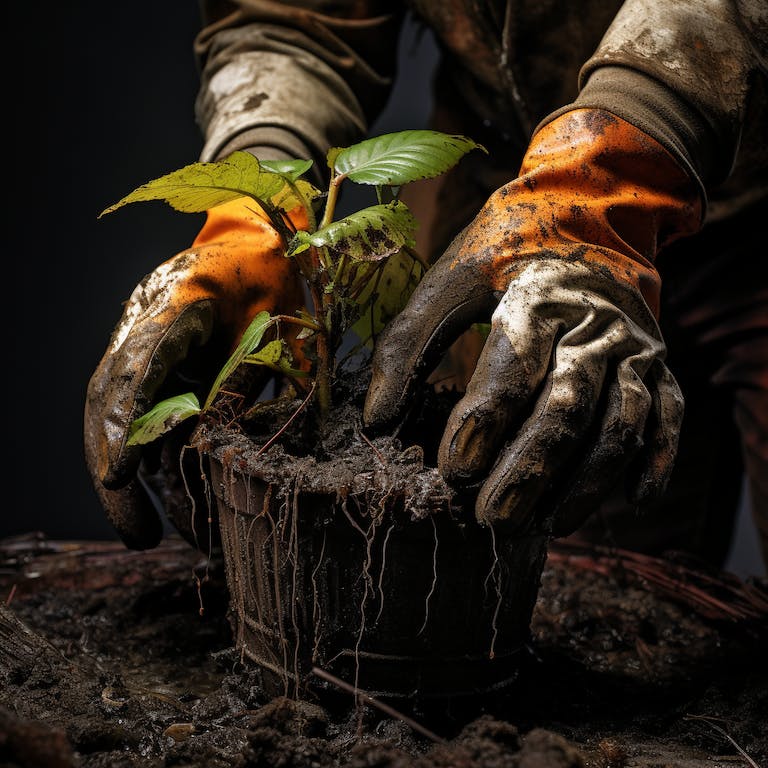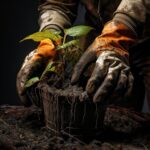We’ve all been there – you proudly nurture your indoor garden, only to discover an unwelcome guest creeping around your plant’s soil: mold.
Don’t fret! Mold growth on indoor plant soil is a common issue that many plant parents face, but the good news is that dealing with it doesn’t have to be a daunting task.
In this guide, we’ll walk you through the basics of understanding why mold appears, the potential risks it poses to your plants, and, most importantly, how to bid farewell to this unwanted visitor.
Whether you’re a seasoned plant parent or just starting your indoor gardening journey, we’ve got you covered with simple, effective solutions to keep your plant babies healthy and thriving. Let’s dive in and reclaim your indoor oasis from the clutches of mold!
Contents
Identifying Mold Growth on Indoor Plant Soil
Assuming you have found mold growth on the soil of your indoor plant, here are a few things you can do:
First, try to identify the type of mold. There are many different types of mold, and some are more harmful than others. If you can’t identify the mold, take a sample of it to your local Cooperative Extension office. They may be able to help you identify it.
Next, try to determine how extensive the mold growth is. If it is just a small spot, you may be able to remove the moldy soil and replace it with fresh soil. If the mold is growing throughout the pot, it is probably best to throw the plant away and start over.
Finally, take steps to prevent mold growth in the future. Be sure to water your plants only when they need it, and allow the soil to dry out between waterings. If you live in a humid climate, consider using a dehumidifier in your home. And, of course, always clean up any mold growth you see as soon as possible.

Causes of Mold Growth on Indoor Plant Soil
Mold is a type of fungi that can grow on just about any surface, including the soil of your indoor plants. While mold itself is not harmful to plants, it can be a sign that there is a problem with the environment that your plant is growing in. Here are some of the most common causes of mold growth on indoor plant soil.
One of the most common causes of mold growth on indoor plant soil is overwatering. When you water your plants, the water seeps down into the soil, and if the soil is already saturated, the excess water will start to pool on the surface.
This creates the perfect environment for mold to grow, as mold loves moist conditions. If you notice mold growth on the soil of your indoor plants, it’s a good idea to cut back on watering and allow the soil to dry out somewhat between watering.
Another common cause of mold growth on indoor plant soil is using too much fertilizer. Just like with overwatering, using too much fertilizer can create conditions that are favorable for mold growth.
When you fertilize your plants, the fertilizer can seep down into the soil and if there is already a lot of fertilizer in the soil, it can start to pool on the surface. Again, this creates the perfect environment for mold to grow.
If you notice mold growth on the soil of your indoor plants, it’s a good idea to cut back on fertilizing and allow the soil to dry out somewhat between fertilizing.
If you live in an area with high humidity, this can also be a contributing factor to mold growth on indoor plant soil. High humidity creates moist conditions, which as we’ve already established, are ideal for mold growth.
If you live in an area with high humidity, it’s important to take measures to improve the drainage of your indoor plant’s soil and to ventilate the area where your plants are growing.
Finally, if you have poor air circulation in the room where your plants are growing, this can also lead to mold growth on the soil. Poor air circulation can cause the air to become stagnant and moist, which again, creates conditions that are ideal for mold growth.
If you suspect that Poor air circulation might be a problem, try opening a window or running a fan in the room where your plants are growing.
If you notice mold growth on the soil of your indoor plants, it’s important to take action to correct the problem. Mold can be a sign of serious problems with the environment that your plants are growing in and if left unchecked, can negatively impact the health of your plants.

Preventing Mold Growth on Indoor Plant Soil
Mold. It’s the stuff that grows on bread when you forget to put it in the fridge. It’s also the stuff that can grow on your indoor plants if you’re not careful.
Mold grows in moist, dark environments. If your indoor plant soil is too wet or doesn’t have good drainage, mold can start to grow.
The first step in preventing mold growth on your indoor plant soil is to make sure the soil is dry. If the top of the soil is dry but the bottom is still wet, you can try using a soil moisture meter to see how wet the soil is down deep.
If the soil is too wet, you can try moving the plant to a drier location or adding more drainage holes to the pot. If the mold is already growing, you’ll need to get rid of it before it spreads to the rest of the plant.
Scrape off the moldy part of the soil and dispose of it in the trash. Then, soak the pot in a solution of bleach and water (1 part bleach to 10 parts water) for 30 minutes. This will kill any mold spores that are left.
After the pot has soaked, rinse it well with water and let it dry completely before replanting. If you’re not sure if the mold is gone, you can also soak the pot in a solution of vinegar and water (1 part vinegar to 10 parts water) for 30 minutes.
Once you’ve taken steps to prevent mold growth, be sure to keep an eye on your indoor plants and check the soil regularly. Mold can be a serious problem for plants, so it’s important to nip it in the bud before it gets out of control.

Treating Mold Growth on Indoor Plant Soil
Mold growth on indoor plant soil is a common problem that can be caused by a variety of factors, including high humidity, poor drainage, or excessive watering. Mold can cause problems for your plants, including stunted growth, yellowing leaves, and root rot.
If you notice mold growing on your indoor plant soil, there are a few things you can do to treat it and prevent it from coming back. First, remove any moldy soil from the pot and dispose of it in the trash.
Then, water your plant less frequently and make sure that the pot has good drainage. You can also place the pot in a sunny spot to help improve air circulation.
If the mold problem persists, you may need to use a fungicide to kill the mold. Be sure to read the label carefully and follow the instructions to avoid harming your plants.

Conclusion:
In conclusion, mold growth on indoor plan soil can be a difficult problem to deal with, but it can be removed. If you find that mold has started to grow on your soil, there are a few things that you can do in order to get rid of it.
First, you will want to make sure that you remove any dead or dying plants from the affected area. This will help to prevent the spread of mold to other parts of your home.
Next, you will want to take measures to improve the drainage of your soil. This can be done by adding more sand or Perlite to the mix. Finally, you will want to make sure that the affected area is well-ventilated. This will help to prevent mold from returning in the future.
FAQs
Why is mold growing in my indoor plant soil?
Mold growth in indoor plant soil is typically due to excess moisture. Overwatering, poor drainage, or high humidity levels can create an ideal environment for mold to thrive. Mold spores are present in most environments, and when combined with moisture, they can lead to the development of mold on the soil’s surface.
Is mold harmful to my plants?
While mold itself may not harm plants directly, it can indicate underlying issues like overwatering or poor ventilation, which can negatively impact plant health. Additionally, certain molds may compete with plants for nutrients. It’s essential to address mold promptly to prevent potential problems.
How can I prevent mold growth in the first place?
To prevent mold, ensure proper watering practices, allowing the soil to dry out between waterings. Use well-draining soil, provide adequate ventilation, and avoid overcrowding plants. Placing a layer of gravel or sand on the soil surface can also discourage mold growth.
Can I reuse the soil after removing mold?
Yes, you can reuse the soil after addressing the mold issue. Remove the affected soil, let it dry completely, and mix in fresh, well-draining soil. Be sure to monitor your watering habits to prevent mold from returning.
What are natural ways to get rid of mold on indoor plant soil?
Natural remedies include sprinkling a thin layer of cinnamon on the soil surface, as cinnamon has antifungal properties. You can also try neem oil, a natural fungicide, or placing charcoal bits on the soil, which helps absorb excess moisture.
Is chemical fungicide safe for indoor plants?
While chemical fungicides are available, it’s advisable to use them sparingly indoors. Opt for mild, organic fungicides if necessary, and follow the instructions carefully. Ensure good ventilation when using any chemical products and keep them out of reach of children and pets.







